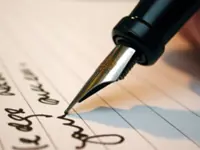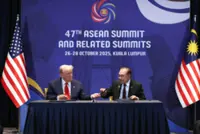For collectors and enthusiasts at the London Autumn Pen Show, the finest writing instruments can cost thousands of dollars. — Photos: AYESHA KAZIM/The New York Times
When was the last time you wrote a letter to someone by hand?
As we entrust our laptops and phones with more and more of our lives, the once-ubiquitous art of handwriting is seemingly in danger of going extinct. But at a London hotel on a recent Sunday morning, thousands of people turned up to demonstrate that the humble pen may be far from meeting the fate of the dinosaurs.
At the autumn London Pen Show, which is one of six planned events from UK Pen Shows this year, you could find yourself face to face with some of the most elegant and expensive pens on the planet – and people happy to pay through the nose for them.
Among the pen sellers was John Sanderson, 72, who sells his handmade creations under the name Silverburl Pens. A retired engineer, Sanderson made his first pen almost 50 years ago as a means of dealing with dyslexia.
“I can’t write and I can’t spell,” he said, “and it’s something that’s always fascinated me. So I made a pen, thinking, ‘I’ll learn to read and write.’” Now he makes pens for people all over the world.
The attendees of the show, including Michaela Staton, 52, Anika Mascher-Licht, 41, and Mareen Goebel, 49, were united by their love of pens. In July, Staton got a bonus at work and splurged on a new pen – a Laban 325 Sakura for about US$125 (RM543). This was her first pen show and she had her sights set on a specific model: an Esterbrook Estie Botanical Gardens fountain pen.
Goebel, on the other hand, was a veteran of three pen shows and she brought along a case brimming with pens, including her favourite, a teal-coloured Pelikan M805 Ocean Swirl, for which she paid about US$485 (RM2,107).
“I think I could get mugged for this pen,” she said, “because apparently it’s really popular and nobody sells theirs.” On this visit, she wanted to find a pen to celebrate her retirement and had set herself a budget of about US$1,300 (RM5,649) – a huge price for an average consumer, but not an extreme one in the world of pen shows.
The consensus among these attendees was that putting pen to paper is more meaningful than typing on gadgets.
“I feel more disconnected from the information that I’m trying to capture when I’m typing it versus when I’m writing it,” Staton said.
‘Warmth and personality’
Pen dealer Roy van den Brink-Budgen, 40, said there is “real warmth and personality” to writing by hand.
“Even if you don’t submerge yourself in it from a collecting point of view, I think writing with a fountain pen adds maybe that extra few percent to even the most mundane writing.”
Van den Brink-Budgen’s Izods pens were – unlike the others on display in the space – encased in transparent boxes, emanating a sense of luxury. While chatting, he was holding a Montblanc Hemingway, the first pen Montblanc made in its Writers Edition series, which he was selling for more than US$3,500 (RM15,211).
He had other high-end pens like a Montblanc Writers Edition Imperial Dragon Solid Gold 888, which he was selling for almost US$6,000 (RM26,076), and said the most he had sold a pen for at a show was about US$12,000 (RM52,152).
Among the highest-priced pens at the show was an out-of-production Namiki Emperor “Hagi,” which was being sold by Sarj Minhas for almost US$20,000 (RM86,920).
It is a voluptuous fountain pen with gold autumn flower designs on black lacquer and an 18-carat gold nib.
Minhas, 53, has been collecting pens for more than 25 years and owns so many he is known by some in the international pen community as “the one-man pen show.” He believes that some pens are meant to stay on display, preserved as heirlooms for the next generation.
“Pens of this quality you don’t really write with,” he said. “This is art of the highest quality.”
The show was not limited to buyers and sellers.
Anyone struggling with getting their pens to write could enlist the help of a nibmeister, like Philip Landsiedel. Landsiedel, 30, who wore a bow tie and a white lab coat, is one of only about 10 people who make a living by altering nibs.
He worked for Montblanc for eight years before starting Landsiedel Fine Writing two years ago. Using a microscope, he will alter a nib however his customer likes.
It is a service designed for people like Michael J. Fiedler, 57, who is so in love with handwriting that he created Working Journal, a book in which photographs of people at work sit opposite pages of their unique handwriting.
After he buys a fountain pen, Fiedler typically won’t use it until he has sent it off to have its nib altered by Japanese craftsmen like Yukio Nagahara or Mike Masuyama.
However, at the show in London, he bought a 1930s Sheaffer Balance with a nib that was particularly flexible. “I may not have to have this one customised,” he said with excitement.
Another service offered, for those who don’t have thousands of dollars to spare, was pen rentals. Having seen the way people rent handbags, Jon Rabbett, 53, thought there should be an equivalent for the pen world. Since 2018, his website, pensharing.com, has attracted around 500 members who pay between US$3 (RM13) and US$13 (RM56) a week to try out pens they might be curious about or unable to afford. As for why it would appeal to someone, Rabbett said, “I can’t afford a villa in the south of France, but I can afford to take a holiday there.”
Goebel, who had been in search of a retirement pen, ended up buying three instead. She fell first for a blue shimmery Conway Stewart for about US$670 (RM4,359) and then couldn’t help buying two pens from Bob Nicolle, who uses a Japanese lacquering style known as “urushi.” For those two pens – one mother-of-pearl and one a complex gold-leaf model – Goebel paid about US$1,170 (RM5,084).
As Fiedler summarised: “You might have something in mind when you come to a pen show. But oftentimes, instead of you finding the pen, the pen finds you.” – By RALPH JONES/ ©2024 The New York Times Company








